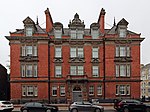Liverpool Cathedral

Liverpool Cathedral is the Cathedral of the Anglican Diocese of Liverpool, built on St James's Mount in Liverpool, and the seat of the Bishop of Liverpool. It may be referred to as the Cathedral Church of Christ in Liverpool (as recorded in the Document of Consecration) or the Cathedral Church of the Risen Christ, Liverpool, being dedicated to Christ 'in especial remembrance of His most glorious Resurrection'. Liverpool Cathedral is the largest cathedral and religious building in Britain, and the eighth largest church in the world. The cathedral is based on a design by Giles Gilbert Scott and was constructed between 1904 and 1978. The total external length of the building, including the Lady Chapel (dedicated to the Blessed Virgin), is 207 yards (189 m) making it the longest cathedral in the world; its internal length is 160 yards (150 m). In terms of overall volume, Liverpool Cathedral ranks as the fifth-largest cathedral in the world and contests with the incomplete Cathedral of St. John the Divine in New York City for the title of largest Anglican church building. With a height of 331 feet (101 m) it is also one of the world's tallest non-spired church buildings and the fourth-tallest structure in the city of Liverpool. The cathedral is recorded in the National Heritage List for England as a designated Grade I listed building.The Anglican cathedral is one of two cathedrals in the city. The Roman Catholic Metropolitan Cathedral of Liverpool is situated approximately half a mile to the north. The cathedrals are linked by Hope Street, which takes its name from William Hope, a local merchant whose house stood on the site now occupied by the Philharmonic Hall, and was named long before either cathedral was built.
Excerpt from the Wikipedia article Liverpool Cathedral (License: CC BY-SA 3.0, Authors, Images).Liverpool Cathedral
Cathedral Gate, Liverpool Georgian Quarter
Geographical coordinates (GPS) Address External links Nearby Places Show on map
Geographical coordinates (GPS)
| Latitude | Longitude |
|---|---|
| N 53.3975 ° | E -2.9730555555556 ° |
Address
Liverpool Cathedral
Cathedral Gate
L1 9AR Liverpool, Georgian Quarter
England, United Kingdom
Open on Google Maps









